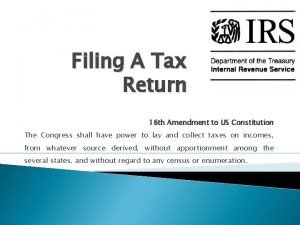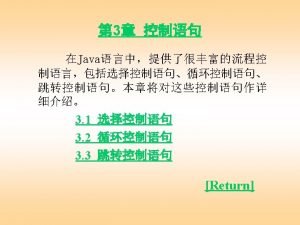Filing a Tax Return Filing Status Filing status
















- Slides: 16

Filing a Tax Return

Filing Status Filing status describes your tax-filing group. You must choose one of the following as your filing status: Single person (not married) Married person filing a joint return Married person filing a separate return Head of household Qualifying widow(er) SLI DE 2 Chapter 3 © 2016 South-Western, Cengage Learning

Exemptions An exemption is an amount you may subtract from your income for each person who depends on your income to live. Each exemption reduces your taxable income and thus your total tax. SLI DE 3 Chapter 3 © 2016 South-Western, Cengage Learning

Exemptions—Who Qualifies Yourself, unless someone else claims you on their return Your spouse, if you are filing jointly Your dependents A dependent is a person who lives with you and for whom you pay more than half of the living expenses. SLI DE 4 Chapter 3 © 2016 South-Western, Cengage Learning

Gross Income Gross income is all the taxable income you receive. Earned income refers to money you earned from working. Unearned income refers to money you received from passive activity (other than working). SLI DE 5 Chapter 3 © 2016 South-Western, Cengage Learning

Forms of Income Wages, salaries, and tips Interest income Dividend income Unemployment compensation Social security benefits Alimony and child support SLI DE 6 Chapter 3 © 2016 South-Western, Cengage Learning

Adjusted Gross Income The law allows you to subtract some types of spending from gross income. You can “adjust” your income by subtracting such things as contributions to individual retirement accounts, student loan interest, and tuition and fees. These adjustments are subtracted from gross income to determine adjusted gross income. Adjustments reduce income that is subject to tax. Note that these adjustments are not available on Form 1040 EZ. SLI DE 7 Chapter 3 © 2016 South-Western, Cengage Learning

Adjusted Gross Income Gross income – Adjustments Adjusted gross income SLI DE 8 Chapter 3 © 2016 South-Western, Cengage Learning

Taxable Income Taxable income is the income on which you will pay tax. Your taxable income determines your tax liability, which is the amount of total tax you owe on a year’s income. SLI DE 9 Chapter 3 © 2016 South-Western, Cengage Learning

(continued) Taxable Income Gross income – Adjustments Adjusted gross income – Deductions – Exemptions Taxable income SLI DE 10 Chapter 3 © 2016 South-Western, Cengage Learning

Deductions Itemized deductions Standard deductions SLI DE 11 Chapter 3 © 2016 South-Western, Cengage Learning

Itemized Deductions Itemized deductions are expenses subtracted from adjusted gross income to determine taxable income. Examples include: Medical and dental expenses beyond a specified percentage of income State and local income taxes Property taxes Home mortgage interest Gifts to charity Losses from theft or property damage Some moving expenses SLI DE 12 Chapter 3 © 2016 South-Western, Cengage Learning

Standard Deduction If you do not have many deductions, your tax may be less if you take the standard deduction. The standard deduction is a stated amount that you may subtract from adjusted gross income instead of itemizing your deductions. This amount changes each year. SLI DE 13 Chapter 3 © 2016 South-Western, Cengage Learning

Tax Credits A tax credit is an amount subtracted directly from the tax owed. It is different from a deduction. A deduction is subtracted from adjusted gross income. A deduction reduces your tax by reducing the amount of income on which the tax is figured. A tax credit reduces the tax itself. The government allows tax credits for certain education expenses, child-care expenses, and other special reasons. SLI DE 14 Chapter 3 © 2016 South-Western, Cengage Learning

Preparing a Tax Return Who must file? Estimated tax Which form to use? Where to begin? Filing electronically: Tax preparation software SLI DE 15 Chapter 3 © 2016 South-Western, Cengage Learning

Form 1040 EZ Step 1: Enter name, address, and Social Security number Step 2: Report income Step 3: Compute tax Step 4: Calculate refund or amount owed Step 5: Sign the return SLI DE 16 Chapter 3 © 2016 South-Western, Cengage Learning
 Nevada department of taxation modified business tax return
Nevada department of taxation modified business tax return Winman software download
Winman software download Draw a supply curve for tax return preparation software
Draw a supply curve for tax return preparation software Draw a supply curve for tax return preparation software
Draw a supply curve for tax return preparation software Gst percentage in india
Gst percentage in india Ralphs annual income is about $32 000
Ralphs annual income is about $32 000 Straight numeric filing
Straight numeric filing Ams filing requirements
Ams filing requirements Importer security filing software
Importer security filing software Procrastinate records
Procrastinate records Patent effective filing date
Patent effective filing date Kelly global logistics
Kelly global logistics Office automated filing systems
Office automated filing systems Sistem terminal digit adalah
Sistem terminal digit adalah Filing system
Filing system Contoh mengindeks nama perusahaan
Contoh mengindeks nama perusahaan Patent effective filing date
Patent effective filing date































